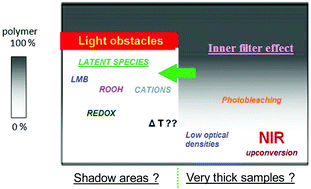Photopolymerization processes of thick films and in shadow areas: a review for the access to composites
Abstract
The photopolymerization processes are currently associated with thin samples for which the light penetration is good enough to activate the photoinitiator or the photoinitiating system for the entre sample's thickness. The photopolymerization of very thick films and in shadow areas where the light penetration is inhibited (e.g. in filled, pigmented, and dispersed samples) remains a huge challenge (e.g. for the access to composites). In the present paper, an overview of the different strategies for the photopolymerization of thick samples is reported. First, strategies based on the optimization of the photonic (light intensity, excitation wavelength, etc.) or chemical (efficiency/reactivity/bleaching of the photoinitiating systems, etc.) parameters are presented that result in a full temporal and spatial control. Then, the main strategies based on propagation/diffusion mechanisms of latent species for the curing beyond the irradiated areas are given (partial loss of spatial resolution and access to shadow areas). Also, dual systems (thermal/photochemical or photochemical/redox) are described. The state of the art for the access to thick samples by photopolymerization processes as well as some perspectives are provided.



 Please wait while we load your content...
Please wait while we load your content...